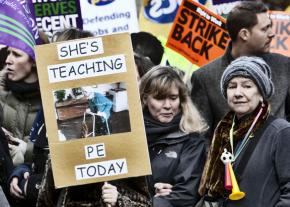Massive strike spreads the fight in Britain
reports on the largest strike in Britain since the 1920s--and how workers are pushing back against plans for drastic cuts and austerity.
SOME 2 million workers from 29 unions participated November 29 in Britain's biggest industrial action since the General Strike of 1926.
The strike involved hundreds of thousands of teachers, civil servants, nurses, local government workers and others. The public-sector workers were striking against proposed changes to their pensions that would see them work longer, pay more into the retirement system and end up with less.
Pension "reform" is part of the Conservative-led coalition government's plan to make workers and the poor pay for the economic crisis and the British government's decision to bail out the banks three years ago.
Despite Prime Minister David Cameron's claims that it would be a "damp squib," the strike effectively shut down Britain's public sector. Picket lines sprang up in hundreds of cities and towns across the country, shutting more than two-thirds of schools and bringing much of the country to a halt.
Huge union rallies took place in many places, with as many as 50,000 workers marching in London, 30,000 in Manchester, and thousands taking part in similar actions in even relatively small cities across Britain.

For many public-sector workers, this was their first experience of strike action. Britain's Guardian newspaper reported the thoughts of one such striker, physiotherapist Megan Williams: "I feel terrible about being on strike...but you put every ounce of yourself into your job, and you keep getting knockbacks, all the time. You're just not appreciated."
Another first-time striker, college catering assistant Sheena Cobb, expressed similar sentiments. "I've got to make a stand," she told the Guardian. "How can I not?"
Discussions are now underway throughout the labor movement and the left about the next steps in the struggle against austerity. One option is a series of sectoral "smart strikes" starting as early as this month, with individual unions or groups of unions taking action as a way of maintaining the momentum built last week.
Others are calling for another all-out day of action similar to the one on November 30, or perhaps even an escalation of struggle through a multi-day work stoppage.
It will be crucial for the unions to keep up the pressure. The scale of the action last week has already forced the government to adopt a more conciliatory tone in its public statements on the pension issue. Although the Tories had threatened to withdraw their latest offer unless the unions accepted it by the end of the year, Cameron's office issued a statement the day after the strike claiming, "We have not set a deadline."
THE NOVEMBER 30 strike comes at the end of a year of inspiring resistance to the austerity agenda in Britain. Almost exactly 12 months ago, thousands of students and youth took to the streets and occupied their campuses to protest rising tuition costs. These militant actions led to violent confrontations with police and a brief takeover of Conservative Party headquarters in London.
The determination of the students injected new life into a British labor movement that had been struggling to respond to the Conservative attacks. With the rank and file clearly sympathetic to the student protests, trade union leaders were forced to call a mass demonstration in London in March of this year, and to begin planning for coordinated strike action to resist the attack on pensions.
The rioting in London and other major British cities this summer added another volatile element to British politics and further highlighted the damage cuts were doing to poor and working-class communities.
The climate of resistance has completely changed public perceptions of the government and the need to fight back. A recent BBC poll found strong support for the strike, with 61 percent of respondents saying they believed workers had a right to resist the attack on their livelihoods and just 28 percent saying they felt the government was handling the economy well. Perhaps most significantly, almost 80 percent of young people supported the strike.
Strong public support for the resistance has forced even mainstream politicians to sit up and take notice. Even the national leadership of the opposition Labour Party, which is committed to more or less the same program of cuts as the coalition government, attacked the Tories' handling of the pension reform and expressed qualified sympathy for striking workers. Reports indicate that many local Labour politicians and rank-and-file party members found their way to picket lines and took part in solidarity actions.
Of course, this does not mean that electing a new Labour government will stave off the attacks on British workers. Far from it: rhetoric aside, very little separates the economic policies of Labour and the Conservative-led coalition.
But the tentative support for the strikers among some Labour politicians does demonstrate the ability of workers to change the whole national dialogue around cuts and austerity. Just a few months ago, the coalition seemed free to pursue its attacks on workers and the poor with very little opposition. Now the government is on the back foot.


